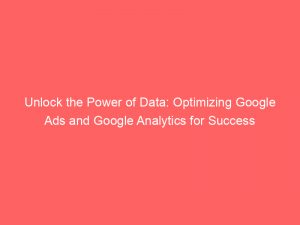Are you a business owner or marketer looking to optimize your advertising strategy? Well, listen up!
Starting July 2023, Universal Analytics will no longer process data, making it essential to migrate to Google Analytics 4. But that’s not all.
By linking Google Analytics to Google Ads, you unlock a world of possibilities. Analyze customer behavior, fine-tune ads and websites, and gain invaluable insights into the entire customer cycle.
However, the process requires administrative access, permissions, and ownership of a Firebase project. Don’t worry, though, because managing linked accounts is a breeze in Google Analytics.
So, buckle up and get ready to boost your ROI with advanced reporting options, conversion tracking, and attribution modeling.
Table of Contents
- google ads and google analytics
- 1. Universal Analytics Properties Will Stop Processing Data Starting July 1, 2023.
- 2. Migrating to Google Analytics 4 Is Essential.
- 3. Linking Google Analytics To Google Ads For Analyzing Customer Activity And Improving Ads And Website.
- 4. Requirements For Linking Accounts: Administrative Access, Auto-Tagging, Ownership Of Firebase Project, And Permissions.
- 5. Importing Google Analytics Data Into A Google Ads Account Managed By A Manager Account.
- 6. Step-By-Step Instructions For Linking And Unlinking Accounts In Google Ads Admin Section.
- 7. Adding Google Analytics 4 Columns to Google Ads Reports.
- 8. Benefits Of Linking Accounts For Tracking The Entire Customer Cycle.
google ads and google analytics
Google Ads and Google Analytics are two powerful tools that, when linked together, provide valuable insights and data for optimizing advertising campaigns and improving website performance. By linking Google Analytics to Google Ads, advertisers can analyze customer activity, track the entire customer cycle, and gain a deeper understanding of campaign performance and user behavior.
This integration allows for more effective targeting, conversion tracking, and attribution modeling, ultimately leading to improved return on ad spend. To link these accounts, administrative access, auto-tagging, ownership of Firebase project, and permissions are required.
Manager accounts can easily import data from Google Analytics into Google Adsfor comprehensive reporting. However, it is important to note that starting from July 1, 2023, Universal Analytics properties will stop processing data, highlighting the need to migrate to Google Analytics 4.
The process of linking and unlinking accounts can be managed through the admin section of Google Ads, and the addition of Google Analytics 4 columns to Google Ads reports is necessary. Importing data from Google Analytics usually takes less than an hour, and it’s essential to remember that deleting a link group will result in the stoppage of data flow.
Overall, the integration of Google Ads and Google Analytics provides advanced reporting options and valuable insights foranalyzing campaign performance and understanding the impact of marketing channels on conversion rates.Key Points:
- Google Ads and Google Analytics provide insights and data for optimizing advertising campaigns and improving website performance.
- Linking Google Analytics to Google Ads allows for analyzing customer activity, tracking the customer cycle, and understanding campaign performance and user behavior.
- The integration enables effective targeting, conversion tracking, and attribution modeling, leading to improved return on ad spend.
- Administrative access, auto-tagging, ownership of Firebase project, and permissions are needed to link the accounts.
- Universal Analytics properties will stop processing data after July 1, 2023, requiring migration to Google Analytics 4.
- Linking and unlinking accounts can be managed through the admin section of Google Ads, with the addition of Google Analytics 4 columns to reports and data import taking less than an hour.
Sources
https://support.google.com/analytics/answer/1033961?hl=en
https://support.google.com/google-ads/answer/7519537?hl=en
https://support.google.com/analytics/answer/9379420?hl=en
https://support.google.com/google-ads/answer/2401634?hl=en
Check this out:
? Pro Tips:
1. Use Google Ads and Google Analytics for advanced reporting and analysis: Integrating Google Ads and Google Analytics provides powerful reporting options to analyze campaign performance and user behavior beyond what is offered individually.
2. Leverage conversion tracking in Google Analytics: By setting up conversion tracking in Google Analytics, you can gain a deeper understanding of which ads and keywords are driving conversions and optimize your campaigns accordingly.
3. Take advantage of attribution modeling in Google Analytics: Attribution modeling in Google Analytics allows you to examine the impact of different marketing channels on conversion rates, providing valuable insights for optimizing your advertising strategies.
4. Be aware of limits when linking accounts: While linking Google Ads and Google Analytics accounts is highly beneficial, keep in mind that there are limits to the number of link groups and Google Ads accounts that can be linked, so plan accordingly.
5. Regularly monitor and manage your account links: Make it a practice to regularly review and manage your account links to ensure data continues to flow seamlessly between Google Ads and Google Analytics.
1. Universal Analytics Properties Will Stop Processing Data Starting July 1, 2023.
Starting from July 1, 2023, Universal Analytics properties will no longer process data.
This means that if you are still relying on Universal Analytics, it is crucial to migrate to Google Analytics 4 to ensure the uninterrupted flow of data and continuation of critical insights. By making this transition, you will be able to leverage the full capabilities of the latest version of Google Analytics and stay ahead in the competitive digital landscape.
Key Takeaway: Migrating to Google Analytics 4 is essential to keep your data processing seamlessly and to make the most out of advanced analytics features.
2. Migrating to Google Analytics 4 Is Essential.
With the discontinuation of Universal Analytics properties, the importance of migrating to Google Analytics 4 cannot be overstated.
By upgrading, you gain access to enhanced features and more accurate data tracking mechanisms that can provide valuable insights into your website traffic, user behavior, and conversion rates. Google Analytics 4 allows you to stay up-to-date with the rapidly evolving digital landscape and make data-driven decisions that drive success.
Key Takeaway: Migrating to Google Analytics 4 is crucial for leveraging the full potential of data analysis and staying ahead in the digital world.
3. Linking Google Analytics To Google Ads For Analyzing Customer Activity And Improving Ads And Website.
Linking your Google Analytics and Google Ads accounts opens up a world of possibilities for analyzing customer activity and enhancing both your ads and website.
By integrating these two powerful platforms, you can gain a deeper understanding of how your ads are performing and how they are driving traffic to your website.
Through combined reporting, you can analyze data from both Google Analytics and Google Ads, enabling you to uncover valuable insights into user behavior and preferences. This information can be used to optimize your ad campaigns, improve targeting, and enhance the overall user experience on your website.
Key Takeaway: Linking Google Analytics to Google Ads provides valuable customer insights, allowing you to optimize your campaigns and improve website performance.
4. Requirements For Linking Accounts: Administrative Access, Auto-Tagging, Ownership Of Firebase Project, And Permissions.
In order to link your Google Analytics and Google Ads accounts, there are several requirements that need to be met.
These include:
By ensuring these requirements are fulfilled, you can successfully establish a connection between Google Analytics and Google Ads and unlock the potential for comprehensive data analysis.
Key Takeaway: Meeting the necessary requirements is essential for successfully linking your Google Analytics and Google Ads accounts and accessing advanced data analysis features.
5. Importing Google Analytics Data Into A Google Ads Account Managed By A Manager Account.
If your Google Ads account is managed by a manager account, you have the ability to import data directly from Google Analytics.
This integration provides a streamlined approach to accessing and utilizing data from both platforms, allowing you to make informed decisions based on comprehensive insights.
By importing Google Analytics data into your Google Ads account, you can gain a holistic view of campaign performance and make data-driven optimizations to improve ad targeting and ROI. This integration saves time and effort by consolidating all relevant data in one place.
Updated for the new year’s advertising best practices.
Key Takeaway: Importing Google Analytics data into a Google Ads account managed by a manager account provides a seamless integration and consolidated data view for better decision-making.
6. Step-By-Step Instructions For Linking And Unlinking Accounts In Google Ads Admin Section.
Linking and unlinking Google Analytics and Google Ads accounts can be easily done through the admin section of Google Ads.
Follow these step-by-step instructions:
To unlink the accounts, simply delete the link group in Google Analytics. However, bear in mind that if a link group is deleted, the data flow will stop immediately.
Key Takeaway: Linking and unlinking accounts is a straightforward process that can be done through the admin section of Google Ads.
7. Adding Google Analytics 4 Columns to Google Ads Reports.
When using Google Analytics 4, it is important to note that the necessary columns need to be added separately to Google Ads reports.
This step allows you to access and analyze the specific metrics and dimensions provided by Google Analytics 4.
By adding these columns to your Google Ads reports, you can gain a comprehensive view of your campaign performance and better understand the impact of your marketing efforts on user behavior and conversion rates.
Key Takeaway: By adding Google Analytics 4 columns to your Google Ads reports, you can access more detailed insights into your campaign performance and user behavior.
8. Benefits Of Linking Accounts For Tracking The Entire Customer Cycle.
Linking your Google Analytics and Google Ads accounts enables you to track the entire customer cycle more effectively.
By analyzing user behavior and conversion data from Google Analytics, you can gain valuable insights into the customer journey, from initial touchpoints to sales and beyond.
This comprehensive view allows you to optimize your ad campaigns at every stage and tailor your marketing strategies to meet the evolving needs and preferences of your audience. By identifying the most effective marketing channels and improving the user experience on your website, you can drive better results and maximize your return on ad spend.
Key Takeaway: Linking Google Analytics and Google Ads provides valuable insights into the customer journey, enabling you to optimize your marketing efforts and maximize ROI.
In conclusion, the integration of Google Ads and Google Analytics is crucial for unlocking the power of data and optimizing your digital marketing strategies. By migrating to Google Analytics 4, linking accounts, and utilizing the advanced reporting options provided by these platforms, you can gain deep insights into customer behavior, improve campaign performance, and drive success in the competitive digital landscape.
Start leveraging the combined power of Google Ads and Google Analytics today to unlock the full potential of your online marketing efforts.
Self-Serve DSP Platform • Advertising Platform for Marketers • Performance Marketing Tips












